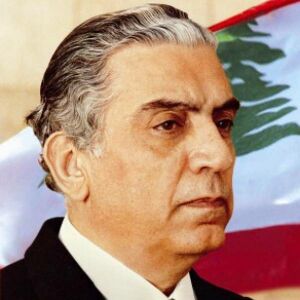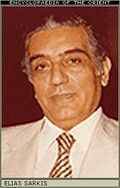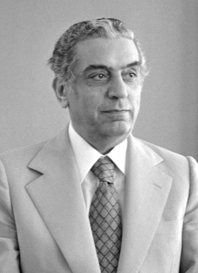إلياس سركيس
Élias Sarkis | |
|---|---|
إلياس سركيس | |
 | |
| رئيس لبنان السادس | |
| في المنصب 23 سبتمبر 1976 – 22 سبتمبر 1982 | |
| رئيس الوزراء | |
| سبقه | سليمان فرنجية |
| خلـَفه | بشير الجميل (منتخب) أمين الجميل |
| تفاصيل شخصية | |
| وُلِد | Élias Youssef Sarkis 20 يوليو 1924 الشعبانية، لبنان |
| توفي | 27 يونيو 1985 (aged 60) Paris, France |
| المثوى | Chebanieh |
| القومية | Lebanese |
| الحزب | Chehabist |
| المدرسة الأم | Saint Joseph University |
| المهنة | Lawyer |
| Religion | Maronite Catholic |
إلياس يوسف سركيس (20 يوليو 1924-27 يونيو 1985) الرئيس السابع للبنان بعد الاستقلال.
تخرج سركيس من كلية الحقوق عام 1948، وعين مديرا للقضاة في القصر الجمهوري في عام 1953 بأمر من الرئيس اللبناني آنذاك فؤاد شهاب. في عام 1968 عين مديرا للبنك المركزي اللبناني. رشح إلياس سركيس نفسه للانتخابات الرئاسية عام 1970 م، إلا أنه خسرها بفارق صوت واحد عن المرشح الآخر سليمان فرنجية، اقترع كمال جنبلاط بالصوت الذي رجح كفة فرنجية، وهو قرار ندم عليه جنبلاط بعد سنوات قليلة. [1]
مع اشتعال نار الحرب الأهلية اللبنانية، فاز بالانتخابات الرئاسية اللبنانية في 8 مايو 1976 في خضم الحرب الأهلية اللبنانية وقبل انتهاء فترته الرئاسية وقعت أحداث غزو لبنان 1982، توفي سركيس في عام 1985 عن عمر يناهز 61 عاما في سويسرا، ولم يتزوج طيلة حياته.
. . . . . . . . . . . . . . . . . . . . . . . . . . . . . . . . . . . . . . . . . . . . . . . . . . . . . . . . . . . . . . . . . . . . . . . . . . . . . . . . . . . . . . . . . . . . . . . . . . . . . . . . . . . . . . . . . . . . . . . . . . . . . . . . . . . . . . . . . . . . . . . . . . . . . . . . . . . . . . . . . . . . . . . .
السيرة
After graduation, Sarkis worked as a lawyer for three years.[2] Next, he became the protege of Lebanese army commander Fuad Chehab who would be the Lebanese president in 1958.[3] Sarkis was then appointed magistrate of the court of accounts and then, director general of the chamber of the presidency of the Republic in 1953.[2] Later, he was appointed governor of the central bank of Lebanon in 1968 and his tenure lasted for 9 years.[2] His appointment was upon the request of then-president Charles Helou, who asked him to reorganize the Lebanese banking systems facing a bank crisis in 1968.[3] Sarkis made the wise decision to increase BDL’s gold reserves between the late 60s and early 70s. Lebanon’s gold is roughly equivalent to 30% of its pre-crisis GDP and is the 17th largest gold reserves holder in the world.[4]
الرئاسة
Sarkis contested the presidential election of 1970 as Chehab's protégé and was expected to win but was defeated by Suleiman Frangieh by a single vote.[5]
Sarkis was, however, elected President for six-year term on 8 May 1976, while the Lebanese Civil War was raging.[6][7][8] He was a candidate of Damascus and preferred president of Hafez Assad.[9][10]
The election was held in the Versailles-style Esseily Villa, a private residence in Southeastern Beirut, since The National Assembly building was not safe due to ongoing attacks and battle.[11] Sixty-six members of the Assembly elected him president on 8 May 1976. On the other hand, twenty-nine members of the Assembly boycotted the session.[11] These members were among leftist and Palestinian groups.[5] His sworn ceremony could not also be held at the Assembly, and he had to sworn at a hotel in the eastern city of Shtaura, 25 miles from Beirut.[5] Sarkis could move to office four months after his election on 23 September 1976,[2] since former President Frangieh objected at first to leave office.[12] Sarkis could appoint Salim Hoss as prime minister in December 1976.[13]
When Sarkis effectively began to serve as the President, he could not forge a lasting accommodation between Christian and Muslim factions. Also, the growing independent power of the Palestinian guerrillas in Lebanon prompted two large-scale Israeli attacks, in 1978 and 1982.[5] Several nationalist and leftist political parties and organizations created the Lebanese National Movement (LNM) under the leadership of Kamal Jumblatt in 1976. The conservative forces led by the Christian Kataeib (Phalange) Party was another block called the Lebanese Front. President Sarkis tried various initiatives to find a negotiated settlement to the conflict, but all were unsuccessful. Because these two groups had their own goals. The Lebanese Front was gradually strengthened its position, awaiting favorable regional developments to impose its own will. The LNM, on the other hand, was too dependent on the Palestinians and unable to initiate a political negotiation process in ceasing the civil war.[14] In November 1976, Sarkis wanted to include Druze za'im Kamal Jumblatt in the cabinet. However, Hafez Assad did not permit it due to Jumblatt's clear opposition to Syria's increasing influence in Lebanon.[15]
On 5 March 1980, Sarkis developed his policy as part of his attempts to create national accord: unity, independence, parliamentarian democracy, rejecting the Camp David Accords between Egypt and Israel. In June 1980, Salim Hoss resigned in protest against his inability to create peace in Lebanon. After much difficulties, Sarkis was able to appoint Shafik Wazzan as new prime minister.[16] Sarkis was described as one who was in office but not in power.[17]
Just before the end of his term in 1982, Israel invaded southern Lebanon in the 1982 Lebanon War and had advanced to the outskirts of Beirut. He organized a peacekeeping force involving U.S., British, French and Italian troops in Beirut after the Israeli invasion of Lebanon to drive out the Palestine Liberation Organization in 1982.[6] In addition, Sarkis formed the rescue committee in 1982 to make arrangements regarding the results of the Israeli invasion.[18] The members of the committee included the Amal movement’s leader, Nabih Berri, and the hardline Christian leader Bashir Gemayel.[18] The body was significant in that it caused tensions in the Amal movement, because Hussein Musawi left the Amal protesting against Berri and founded Islamic Amal after this event.[18]
Sarkis gained the respect of many Lebanese during his term, but critics accused him of indecisiveness.[6] However, he was regarded as the choice of Syria but not the Muslim-Palestinian alliance. For that reason, 29 members of the Assembly boycotted the election session.[11]
الخلافة
Sarkis was to be succeeded by Bachir Gemayel, who was elected president on 23 August 1982 with 57 votes.[11] However, Gemayel was assassinated 21 days before he was due to take office. Amine Gemayel, Bachir's brother, was subsequently elected in his stead, and Sarkis handed the presidency over to him on 23 September 1982.[11]
الوفاة
Sarkis died in Paris from cancer on 27 June 1985, at the age of 60.[2][3][5] His body was returned to Lebanon.[3] Then-Lebanese President Amine Gemayel led mourners at his funeral in Beirut on 29 June 1985. The requiem mass in East Beirut was attended by a Syrian delegation led by a government minister representing then Syrian president Hafez Assad. His body was buried in his hometown, Chebanieh, on the same day.[19]
الهامش
- ^ حرب لبنان جـ2 جذور الصراع - من موقع قناة الجزيرة.
- ^ أ ب ت ث ج خطأ استشهاد: وسم
<ref>غير صحيح؛ لا نص تم توفيره للمراجع المسماةPRL - ^ أ ب ت ث "Former Lebanese President Elias Sarkis dies". Lakeland Ladger. The Associated Press. 28 June 1985. Retrieved 10 June 2012.
- ^ "The Story of Lebanon's Gold".
- ^ أ ب ت ث ج "Ex-Lebanese Leader Sarkis Dies at 60 in Paris Hospital". Los Angeles Times. 28 June 1985. Retrieved 10 June 2012.
- ^ أ ب ت "Elias Sarkis, Former Lebanese President". Orlando Sentinel. 28 June 1985. Retrieved 10 June 2012.
- ^ David S. Sorenson (12 November 2009). Global Security Watch—Lebanon: A Reference Handbook. ABC-CLIO. p. 7. ISBN 978-0-313-36579-9.
- ^ "Lebanon's presidency – a source of strife since 1976". Lebanonwire. Beirut. DPA. 22 نوفمبر 2007. Archived from the original on 20 يناير 2013. Retrieved 19 مارس 2013.
- ^ Dominique Avon; Anaïs-Trissa Khatchadourian; Jane Marie Todd (2012). Hezbollah: A History of the "Party of God". Harvard University Press. p. 18. ISBN 978-0-674-06752-3.
- ^ Kathy A. Zahler (2009). The Assads' Syria. Twenty-First Century Books. p. 10. ISBN 978-0-8225-9095-8.
- ^ أ ب ت ث ج "Middle East Issues". About.com. 2007. Archived from the original on 9 March 2012. Retrieved 10 June 2012.
- ^ "Elias Sarkis". Rulers. Retrieved 23 July 2012.
- ^ The Middle East and North Africa 2003. Europa Publications. 2003. p. 686. ISBN 978-1-85743-132-2.
- ^ Hassan Krayem. "The Lebanese civil war and the Taif agreement". American University of Beirut. Retrieved 10 June 2012.
- ^ Nisan Mordechai. "The Syrian occupation of Lebanese" (PDF). ACPR. Archived from the original (PDF) on 28 September 2013. Retrieved 5 July 2012.
- ^ خطأ استشهاد: وسم
<ref>غير صحيح؛ لا نص تم توفيره للمراجع المسماةwofl - ^ Edgar O'Ballance (1998). Civil War in Lebanon, 1975–92. Palgrave. p. 7. ISBN 9780312215934.
- ^ أ ب ت Mohammad Harfoush (18 February 2013). "Hezbollah, Part 1: Origins and Challenges". Al Monitor. Retrieved 24 March 2013.
- ^ "Sarkis, Ex-Lebanese President, is Buried". Los Angeles Times. Reuters. 30 June 1985. Retrieved 10 June 2012.
الوصلات الخارجية
| مناصب سياسية | ||
|---|---|---|
| سبقه سليمان فرنجية |
رئيس لبنان 1976–1982 |
تبعه بشير الجميل |

